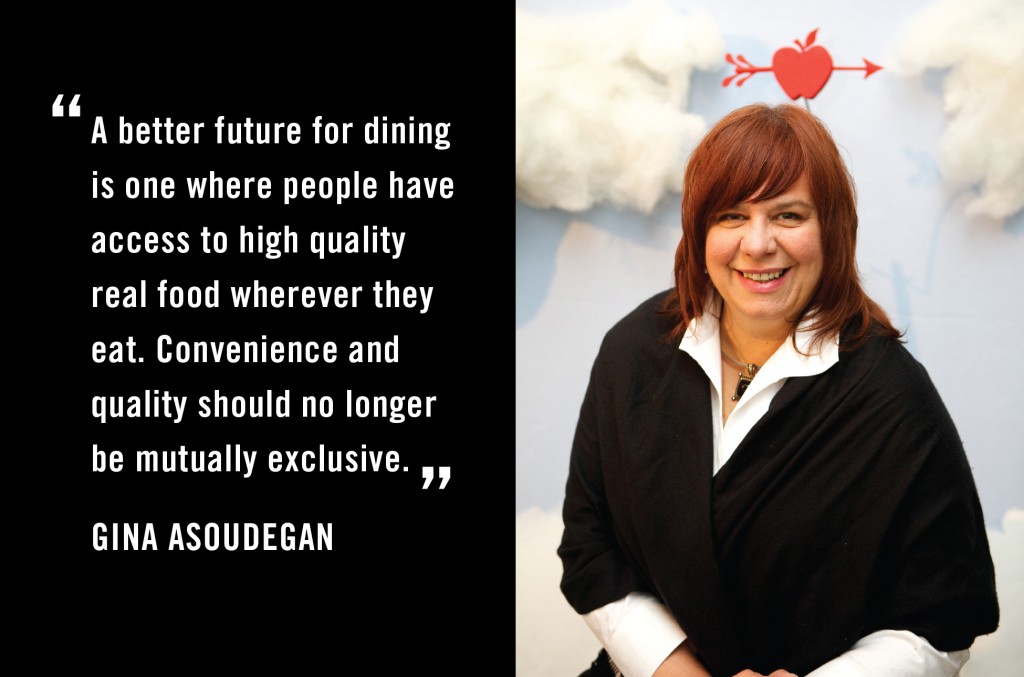Every week during our future of dining editorial series, we’re sharing an interview with one of our Hack//Dining NYC collaborating partners. During week 1 we shared our Q&A with celebrity chef Mario Batali, and last week we posted our Q&A with Michiel Bakker, Director of Global Food Services at Google.
This week we’re thrilled to share our Q&A with Gina Asoudegan, Director of Communications for Applegate, who discusses how technology and hackathons can help the company fulfill its mission of “changing the meat we eat.” She talks about how technology can empower both small scale producers and customers to transform the way our meat is farmed, distributed and consumed.
Gina also touches on how Applegate has started using the hackathon model internally to address challenges and spark innovation and why Applegate sees foodservice as a major catalyst for food system change.
Check out our interview below to learn all about Applegate’s vision for the future of dining and learn more about its hackathon challenge here.
______________________________
Food+Tech Connect: Can you tell us a little about you and your role at Applegate?
Gina Asoudegan: I’ve been involved with food in one aspect or another for nearly 25 years. I started as a restaurateur and caterer, taught culinary arts at a vocational high school and implemented a farm to table curriculum there, worked as a restaurant consultant developing concepts and menu items (including McDonald’s yogurt parfait!) and started a non-profit to develop markets and infrastructure for the sale and distribution of local food in Bucks County, PA.
In my current role at Applegate, I lobby and work on issues like GMOs and the overuse of antibiotics in animals raised for food. However, I’m increasingly interested in how technology can be applied to these issues and to the food system in general. For instance, I’ve seen how technology can be used in the nose to tail utilization of meat, which is the key to profitability for a farmer raising animals. I’ve also seen how technology can be applied to streamline the processing and distribution of meat and poultry from networks of regional farms in order to give them the economies of scale and streamlined supply chain necessary to sell to large foodservice accounts like hospitals and school districts.
FTC: What does a better future for dining look like to you?
GA: For me, a better future for dining is one where people have access to high quality real food wherever they eat. Convenience and quality should no longer be mutually exclusive.
FTC: This is the third hackathon Applegate has co-hosted with Food+Tech Connect. Why are hackathons important and what’s their value for your company?
GA: The hackathons are interesting to us for a couple of reasons. First, they address food system challenges in a holistic way by bringing together a variety of people with diverse backgrounds who can look at problems from various perspectives. It’s rare that issues within the food system are tackled by groups that contain techies, designers, farmers, policymakers, entrepreneurs, etc. At the last hackathon (Hack//Meat SV), Applegate prepared a challenge that we were certain we understood from every angle. However, when we presented it to the attendees, someone spoke up and completely reframed the problem in a way we never could have done with the knowledge base we were working from. Another benefit the hackathons have had for our company is that they’ve provided us with a model that we can use internally to address challenges and spark innovation.
FTC: What role does technology play in fulfilling Applegate’s mission to change the meat we eat?
GA: There are many areas where technology can be applied in the food system that will impact Applegate’s mission. For example, technology can assist with aggregating smaller, regional livestock farmers and with streamlining their processing and distribution channels so they can sell to large scale purchasers like hospitals, school districts – or even Applegate.
Technology can also be used to measure consumer sentiment on food-related issues, which could greatly assist with lobbying for legislation like GMO labeling and removing antibiotics from animal agriculture. Imagine if we could provide a real number to legislators that would let them know what the sentiment is on various issues with voters in their districts. Such a measurement would also let us know where we should focus our efforts to raise awareness.
FTC: Applegate’s hackathon challenge is focused on how technology can make it easier for distributors and operators to get natural and organic products on the plates of foodservice consumers. Why is this such a big challenge, and why is it so important?
GA: The size and scale of the foodservice market are what make it both important and a challenge. Foodservice has the ability to change the face of agriculture with its purchasing decisions. For instance, imagine if every hospital in the US decided to serve only antibiotic-free meat and poultry. That one large scale decision would change, for the better, the way millions of animals are raised for food. It would also remove millions of pounds of antibiotics from the food system, where they’re currently overused on animals and causing antibiotic-resistance in humans. However, embedded in this opportunity is also the challenge.
If hospitals made a decision like this today, there wouldn’t be enough supply of antibiotic-free meat and poultry to meet this level of demand overnight. Some farmers would need to convert their farms and learn how to raise animals without antibiotics (more space, better food, etc..) Other farmers would need to find networks and distribution channels to sell their meat to these institutions. It’s all possible, but it will take new ideas and solutions – many of which will involve technology.
Hacking Dining is online conversation exploring how we might use technology and design to hack a better future for dining. Join the conversation between June 2-30, and share your ideas in the comments, on Twitter using #hackdining, Facebook, LinkedIn or Tumblr.




